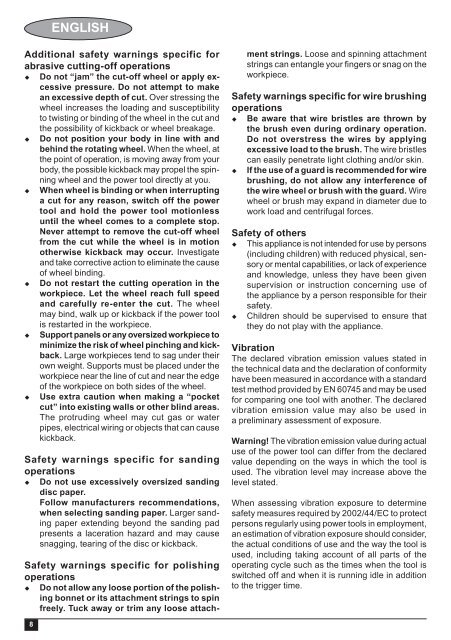BlackandDecker Smerigliatrice Angolare Piccola- Ast15 - Type 3 - Instruction Manual (Europeo Orientale)
BlackandDecker Smerigliatrice Angolare Piccola- Ast15 - Type 3 - Instruction Manual (Europeo Orientale)
BlackandDecker Smerigliatrice Angolare Piccola- Ast15 - Type 3 - Instruction Manual (Europeo Orientale)
You also want an ePaper? Increase the reach of your titles
YUMPU automatically turns print PDFs into web optimized ePapers that Google loves.
ENGLISH<br />
Additional safety warnings specific for<br />
abrasive cutting-off operations<br />
Do not “jam” the cut-off wheel or apply excessive<br />
pressure. Do not attempt to make<br />
an excessive depth of cut. Over stressing the<br />
wheel increases the loading and susceptibility<br />
to twisting or binding of the wheel in the cut and<br />
the possibility of kickback or wheel breakage.<br />
Do not position your body in line with and<br />
behind the rotating wheel. When the wheel, at<br />
the point of operation, is moving away from your<br />
body, the possible kickback may propel the spinning<br />
wheel and the power tool directly at you.<br />
When wheel is binding or when interrupting<br />
a cut for any reason, switch off the power<br />
tool and hold the power tool motionless<br />
until the wheel comes to a complete stop.<br />
Never attempt to remove the cut-off wheel<br />
from the cut while the wheel is in motion<br />
otherwise kickback may occur. Investigate<br />
and take corrective action to eliminate the cause<br />
of wheel binding.<br />
Do not restart the cutting operation in the<br />
workpiece. Let the wheel reach full speed<br />
and carefully re-enter the cut. The wheel<br />
may bind, walk up or kickback if the power tool<br />
is restarted in the workpiece.<br />
Support panels or any oversized workpiece to<br />
minimize the risk of wheel pinching and kickback.<br />
Large workpieces tend to sag under their<br />
own weight. Supports must be placed under the<br />
workpiece near the line of cut and near the edge<br />
of the workpiece on both sides of the wheel.<br />
Use extra caution when making a “pocket<br />
cut” into existing walls or other blind areas.<br />
The protruding wheel may cut gas or water<br />
pipes, electrical wiring or objects that can cause<br />
kickback.<br />
Safety warnings specific for sanding<br />
operations<br />
Do not use excessively oversized sanding<br />
disc paper.<br />
Follow manufacturers recommendations,<br />
when selecting sanding paper. Larger sanding<br />
paper extending beyond the sanding pad<br />
presents a laceration hazard and may cause<br />
snagging, tearing of the disc or kickback.<br />
Safety warnings specific for polishing<br />
operations<br />
Do not allow any loose portion of the polishing<br />
bonnet or its attachment strings to spin<br />
freely. Tuck away or trim any loose attachment<br />
strings. Loose and spinning attachment<br />
strings can entangle your fi ngers or snag on the<br />
workpiece.<br />
Safety warnings specific for wire brushing<br />
operations<br />
Be aware that wire bristles are thrown by<br />
the brush even during ordinary operation.<br />
Do not overstress the wires by applying<br />
excessive load to the brush. The wire bristles<br />
can easily penetrate light clothing and/or skin.<br />
If the use of a guard is recommended for wire<br />
brushing, do not allow any interference of<br />
the wire wheel or brush with the guard. Wire<br />
wheel or brush may expand in diameter due to<br />
work load and centrifugal forces.<br />
Safety of others<br />
This appliance is not intended for use by persons<br />
(including children) with reduced physical, sensory<br />
or mental capabilities, or lack of experience<br />
and knowledge, unless they have been given<br />
supervision or instruction concerning use of<br />
the appliance by a person responsible for their<br />
safety.<br />
Children should be supervised to ensure that<br />
they do not play with the appliance.<br />
Vibration<br />
The declared vibration emission values stated in<br />
the technical data and the declaration of conformity<br />
have been measured in accordance with a standard<br />
test method provided by EN 60745 and may be used<br />
for comparing one tool with another. The declared<br />
vibration emission value may also be used in<br />
a preliminary assessment of exposure.<br />
Warning! The vibration emission value during actual<br />
use of the power tool can differ from the declared<br />
value depending on the ways in which the tool is<br />
used. The vibration level may increase above the<br />
level stated.<br />
When assessing vibration exposure to determine<br />
safety measures required by 2002/44/EC to protect<br />
persons regularly using power tools in employment,<br />
an estimation of vibration exposure should consider,<br />
the actual conditions of use and the way the tool is<br />
used, including taking account of all parts of the<br />
operating cycle such as the times when the tool is<br />
switched off and when it is running idle in addition<br />
to the trigger time.<br />
8
















